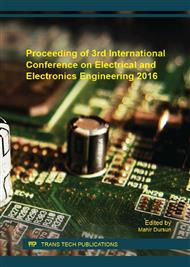[1]
U. Minnaar, C. Gaunt, and F. Nicolls, Characterisation of power system events on South African transmission power lines, Electric power systems research, vol. 88, (2012).
DOI: 10.1016/j.epsr.2012.01.015
Google Scholar
[2]
K. Silva, B. Souza, and N. Brito, Fault detection and classification in transmission lines based on wavelet transform and ANN, Power Delivery, IEEE Trans. on, vol. 21, (2006).
DOI: 10.1109/tpwrd.2006.876659
Google Scholar
[3]
M. J. B. Reddy, D. V. Rajesh, and D. Mohanta, Robust transmission line fault classification using wavelet multi-resolution analysis, Computers & Electrical Eng., vol. 39, (2013).
DOI: 10.1016/j.compeleceng.2013.02.013
Google Scholar
[4]
B. Vyas, R. P. Maheshwari, and B. Das, Evaluation of AI Techniques for Fault Type Identification in Advanced Series Compensated Trans. Lines, IETE J. of Research, (2014).
DOI: 10.1080/02564602.2014.893767
Google Scholar
[5]
Z. He, S. Lin, Y. Deng, X. Li, and Q. Qian, A rough membership neural network approach for fault classification in transmission lines, Int. J. of Elec Power & Energy Syts, (2014).
DOI: 10.1016/j.ijepes.2014.03.027
Google Scholar
[6]
S. Muyeen, H. M. Hasanien, and A. Al-Durra, Transient stability enhancement of wind farms connected to a multi-machine power system by using an adaptive ANN-controlled SMES, Energy Conversion and Management, vol. 78, (2014).
DOI: 10.1016/j.enconman.2013.10.039
Google Scholar
[7]
H. -L. Chen, C. -C. Huang, X. -G. Yu, X. Xu, X. Sun, G. Wang, et al., An efficient diagnosis system for detection of Parkinson's disease using fuzzy k-nearest neighbor approach, Expert systems with applications, vol. 40, (2013).
DOI: 10.1016/j.eswa.2012.07.014
Google Scholar
[8]
O. Castillo, P. Melin, E. Ramírez, and J. Soria, Hybrid intelligent system for cardiac arrhythmia classification with Fuzzy K-Nearest Neighbors and neural networks combined with a fuzzy system, Expert Systems with Applications, vol. 39, (2012).
DOI: 10.1016/j.eswa.2011.08.156
Google Scholar
[9]
H. -B. Shen, J. Yang, and K. -C. Chou, Fuzzy KNN for predicting membrane protein types from pseudo-amino acid composition, Journal of theoretical biology, vol. 240, (2006).
DOI: 10.1016/j.jtbi.2005.08.016
Google Scholar
[10]
S. Ekici, Support vector machines for classification and locating faults on transmission lines, Applied Soft Computing, vol. 12, (2012).
DOI: 10.1016/j.asoc.2012.02.011
Google Scholar
[11]
J. M. Keller, M. R. Gray, and J. A. Givens, A fuzzy k-nearest neighbor algorithm, Systems, Man and Cybernetics, IEEE Transactions on, (1985).
DOI: 10.1109/tsmc.1985.6313426
Google Scholar
[12]
I. Saini, D. Singh, and A. Khosla, QRS detection using K-Nearest Neighbor algorithm (KNN) and evaluation on standard ECG databases, J. of advanced research, vol. 4, (2013).
DOI: 10.1016/j.jare.2012.05.007
Google Scholar
[13]
H. Liu and S. Zhang, Noisy data elimination using mutual k-nearest neighbor for classification mining, Journal of Systems and Software, vol. 85, (2012).
DOI: 10.1016/j.jss.2011.12.019
Google Scholar
[14]
E. Nasibov and C. Kandemir-Cavas, Efficiency analysis of KNN and minimum distance-based classifiers in enzyme family prediction, Comp. biology and chemistry, (2009).
DOI: 10.1016/j.compbiolchem.2009.09.002
Google Scholar


